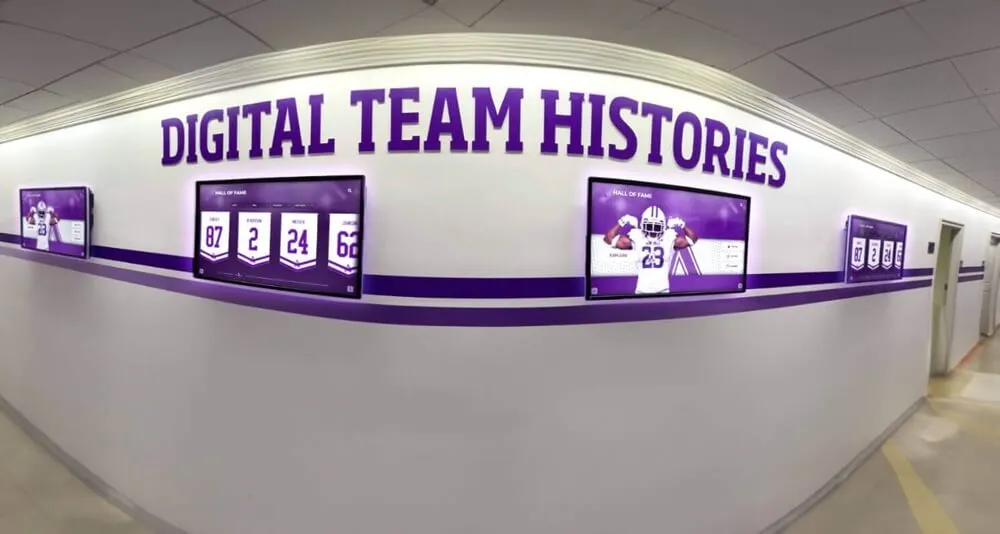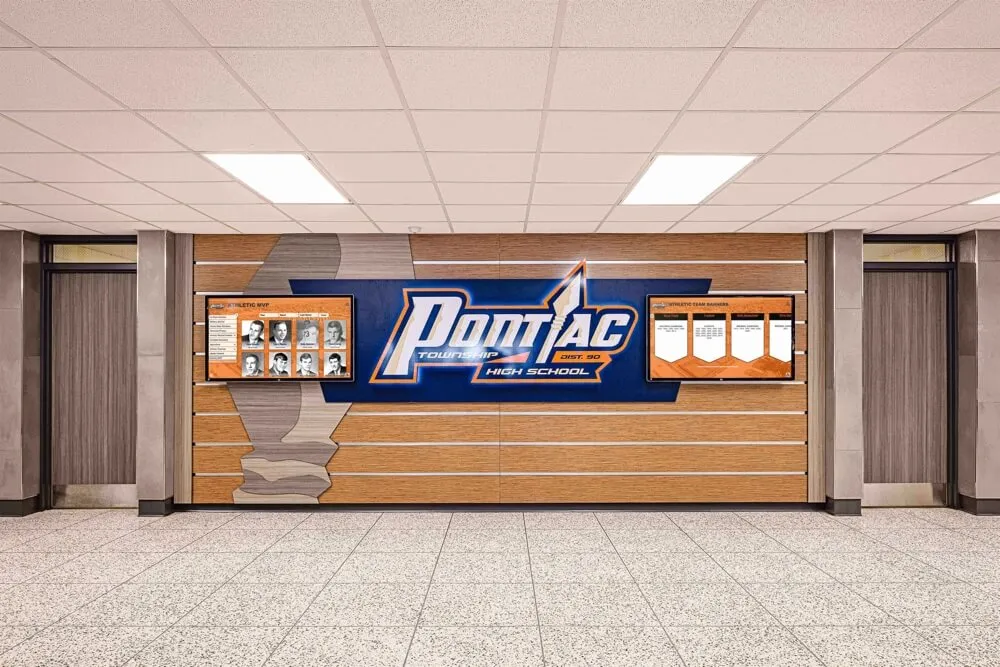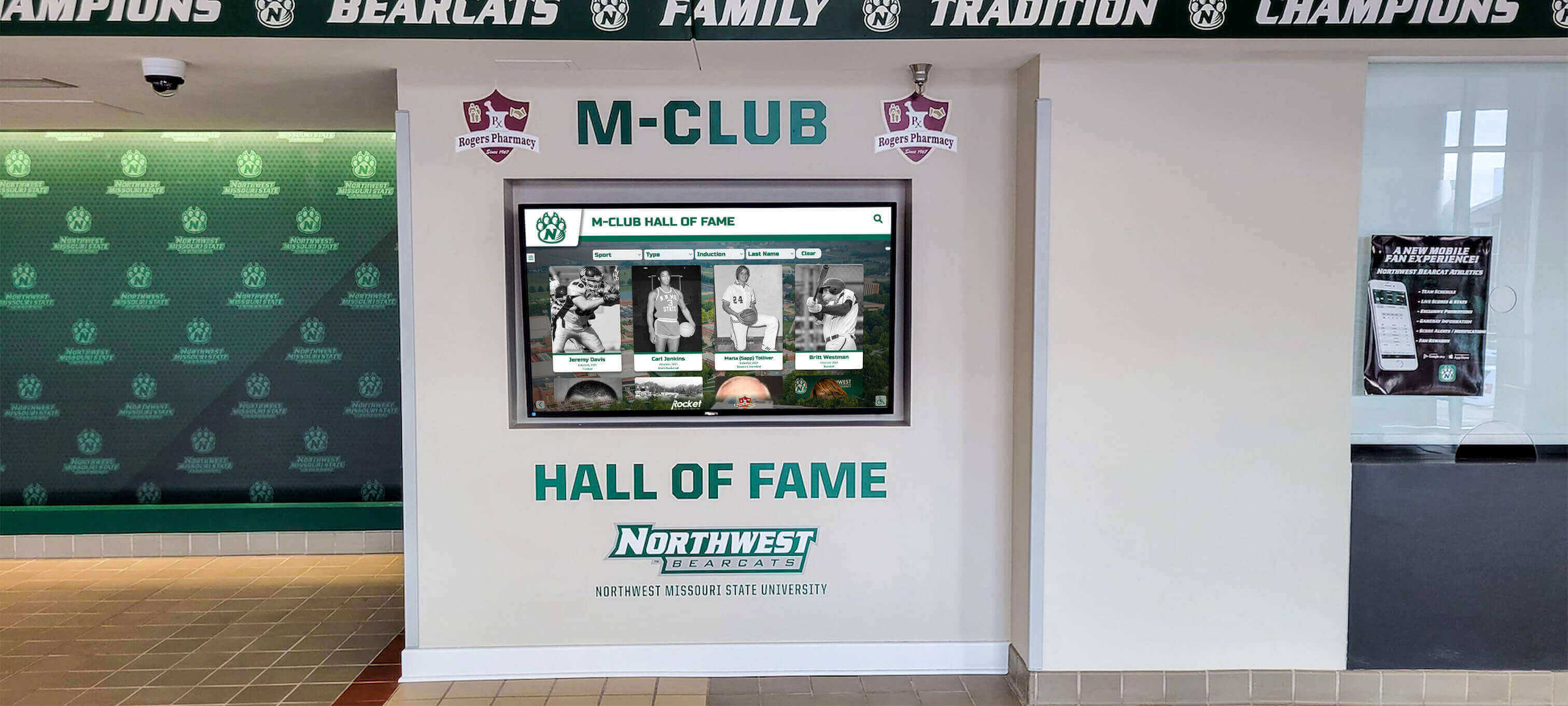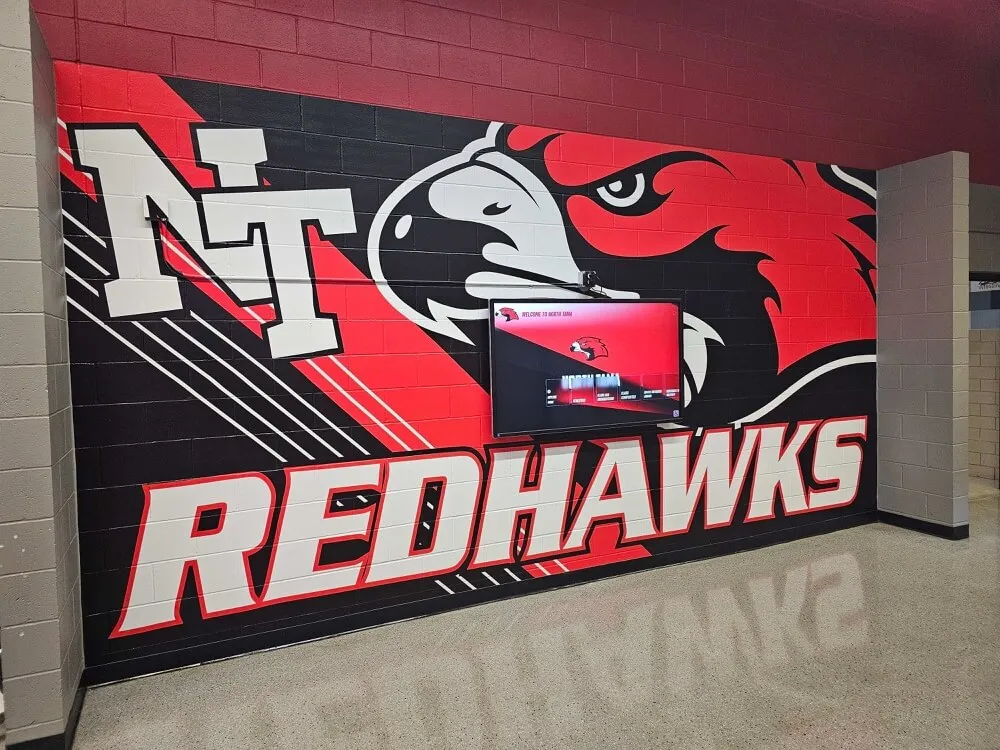Key Takeaways
Discover 15+ innovative school hallway remodeling ideas that combine modern design, digital recognition displays, and interactive learning spaces to transform your institution's corridors into inspiring educational environments.
This comprehensive guide explores innovative school hallway remodeling ideas combining proven design strategies, digital recognition solutions, and practical implementation advice. Whether you’re planning a complete hallway renovation or seeking cost-effective improvements to refresh existing spaces, discover how modern remodeling approaches create hallways that inspire, engage, and celebrate your school community while maximizing your facility investment.
Why School Hallway Remodeling Matters
School hallways serve as the connective tissue of educational facilities, and their design profoundly impacts daily school experience. Understanding the benefits of thoughtful hallway remodeling helps justify investments and guide design decisions.
The Impact of Well-Designed Hallways
Research on educational environments consistently demonstrates that physical space design influences student behavior, engagement, and academic outcomes. Well-designed hallways contribute to positive school culture by:
Creating Pride and Belonging
Hallways showcasing achievement, school history, and student work communicate that excellence matters and every student belongs. When students see themselves and their accomplishments reflected throughout the building, connection to school community strengthens significantly.
Extending Learning Opportunities
Modern hallway designs incorporate educational content, interactive elements, and learning nooks that transform transition time into engagement opportunities. Students encounter information, challenges, and inspiration throughout their day beyond formal classroom instruction.
Improving Safety and Supervision
Proper lighting, clear sightlines, reduced congestion points, and strategic design elements improve safety while making supervision more effective. Well-designed hallways naturally encourage positive behavior and discourage problems.

Strengthening School Brand and Reputation
First impressions matter tremendously. Prospective families, visitors, and community members form lasting opinions based on facility appearance. Professional, well-maintained hallways signal institutional quality and pride.
Schools implementing comprehensive hallway remodeling projects report measurable improvements in student behavior, family satisfaction, community perception, and even staff morale—benefits extending far beyond aesthetics.
Planning Your School Hallway Remodeling Project
Successful hallway renovations begin with thorough planning that balances aspirations with practical constraints while ensuring improvements align with institutional needs and values.
Assessment and Goal Setting
Current State Analysis
Begin by honestly assessing your existing hallways:
- Physical condition: paint, flooring, lighting, ceiling tiles
- Functionality: traffic flow, congestion points, accessibility
- Visual appeal: outdated elements, blank walls, disorganization
- Technology: existing displays, connectivity, outdated systems
- Recognition: how achievements are currently displayed
- Student engagement: whether hallways serve beyond transition
Stakeholder Input
Gather perspectives from multiple groups:
- Students: what would make hallways more interesting and useful
- Teachers: how hallways could support learning objectives
- Administrators: priorities for improvement and budget constraints
- Facilities staff: maintenance and durability considerations
- Parents and community: perceptions and expectations
Priority Setting
Not every hallway requires the same level of investment. Identify high-impact areas:
- Main entrance and lobby areas seen by all visitors
- High-traffic corridors used by entire student body
- Athletic wing hallways where sports culture lives
- Academic hallways serving specific departments
- Common areas where students naturally gather
Budget Development and Funding
Cost Categories to Consider
- Structural improvements: flooring, ceiling, walls, lighting
- Technology integration: displays, interactive elements, infrastructure
- Visual design: murals, graphics, signage, branding
- Furniture and fixtures: seating, display cases, bulletin boards
- Professional services: designers, contractors, installers
Funding Sources
- Capital improvement budgets
- Booster club and parent organization fundraising
- Alumni association contributions
- Local business sponsorships
- Grant programs for educational facilities
- Phased implementation spreading costs over multiple years
Modern digital recognition solutions like those from Rocket Alumni Solutions often prove more cost-effective long-term than traditional approaches, as they eliminate ongoing costs for adding new plaques and provide unlimited capacity for celebrating achievements without physical space constraints.

Modern School Hallway Design Elements
Contemporary hallway remodeling incorporates diverse elements creating spaces that inspire, inform, engage, and celebrate rather than simply connecting point A to point B.
Digital Recognition and Information Displays
Digital displays represent one of the most impactful additions to modern school hallways, transforming how institutions celebrate achievement while providing dynamic information capabilities.
Interactive Touchscreen Displays
Digital hall of fame systems allow schools to showcase unlimited achievements through high-quality multimedia presentations. Unlike traditional trophy cases with finite space, digital solutions enable recognition of diverse accomplishments across academics, athletics, arts, service, and character.
Key advantages include:
- Unlimited capacity eliminating difficult decisions about who gets recognized
- Easy web-based updates requiring no physical reinstallation
- Rich multimedia content including photos, videos, and detailed stories
- Interactive search allowing visitors to explore achievements
- Social media integration extending recognition beyond physical building
- Long-term cost savings compared to traditional plaque systems
Schools implementing touchscreen recognition displays report dramatically increased engagement, with students regularly interacting with achievement content and alumni maintaining stronger connections through ongoing access to institutional history.

Digital Signage for Information
Beyond recognition, digital displays serve practical purposes:
- Daily announcements and event calendars
- Emergency communication capabilities
- Wayfinding assistance for visitors
- Student artwork and project showcases
- Live sports scores and competition updates
- Educational content and trivia
Integration of digital displays requires planning for:
- Electrical power and network connectivity
- Mounting hardware and protective enclosures
- Content management system access and training
- Ongoing maintenance and technical support
Visual Design and School Branding
Strong visual identity transforms generic hallways into spaces that unmistakably belong to your institution while celebrating what makes your community unique.
Wall Murals and Graphics
Professional murals create dramatic visual impact while communicating institutional values and history. Effective mural programs include:
- School mascot and athletic graphics reinforcing team identity
- Historical timelines documenting institutional legacy
- Inspirational quotes and messages reflecting core values
- Subject-specific graphics supporting academic departments
- Student-designed artwork celebrating creative talent
- Community partnerships showcasing local culture

When commissioning murals, consider durability, maintenance requirements, and whether designs remain relevant over time. Many schools combine permanent structural murals with changeable elements allowing updates without complete redesign.
Color Schemes and Branding
Consistent use of school colors creates cohesive visual identity:
- Accent walls in school colors at key locations
- Color-coded hallways aiding wayfinding by department
- Branded signage using consistent typography and logos
- Coordinated furniture and fixtures reflecting color palette
Professional hall of fame wall design integrates seamlessly with overall facility branding, creating recognition spaces that enhance rather than compete with surrounding environment.
Learning Extensions and Interactive Elements
Forward-thinking schools design hallways as learning spaces rather than mere corridors, incorporating elements that engage students throughout the day.
Interactive Learning Displays
Transform empty walls into educational opportunities:
- STEM challenges and puzzles students solve during passing periods
- Historical photo galleries with explanatory text
- Literary quotes and vocabulary enrichment
- Math and science concepts illustrated visually
- Foreign language phrases and cultural information
- Current events and global awareness displays
Student Work Showcases
Dedicated spaces for displaying student work validate achievement while inspiring peers:
- Rotating art galleries with professional mounting systems
- Writing showcases featuring exceptional student work
- Science fair and research project highlights
- Photography exhibits and multimedia presentations
- 3D project displays in secure cases
Schools using digital display platforms can showcase student work alongside achievement recognition, creating comprehensive celebration of excellence across all domains.

Seating Areas and Collaborative Spaces
Modern hallway design incorporates furniture and space allocation that encourages productive student interaction rather than simply rushing between classes.
Strategic Seating Placement
Well-designed seating areas provide:
- Alcoves with benches for quiet study between classes
- Small group collaboration areas with tables and chairs
- Informal gathering spaces near cafeterias and common areas
- Window seats taking advantage of natural light
- Charging stations supporting device usage
Design Considerations
Hallway furniture requires special attention to:
- Durability withstanding heavy daily use
- Easy cleaning and maintenance
- Supervision visibility for safety
- Traffic flow preservation avoiding congestion
- Storage integration where appropriate
- Accessibility meeting ADA requirements
The combination of modern recognition displays with comfortable seating creates natural gathering points where students pause to explore achievements and connect with peers.
Lighting and Atmosphere
Lighting dramatically impacts how hallways feel while affecting safety, energy costs, and maintenance requirements.
Natural Light Maximization
Where possible, increase natural light through:
- Strategic window placement or expansion
- Interior windows borrowing light from classrooms
- Skylights or light tubes in interior corridors
- Light-colored surfaces reflecting available light
- Removal of obstacles blocking windows
Artificial Lighting Upgrades
Modern LED lighting provides:
- Significant energy cost savings
- Longer lifespan reducing maintenance
- Better color rendering improving appearance
- Dimming capabilities for flexibility
- Enhanced safety through consistent illumination
Proper lighting ensures digital displays remain clearly visible while creating welcoming atmosphere that reduces institutional feel common in older facilities.
Recognition-Focused Hallway Remodeling
For many schools, the primary remodeling goal involves improving how they celebrate achievement and honor excellence. Recognition-focused renovations combine physical design with technology solutions creating inspiring displays.
Creating Comprehensive Recognition Programs
Effective recognition hallways celebrate diverse achievements ensuring students with varied talents find pathways to acknowledgment.
Athletic Recognition
Athletic hallway renovations typically include:
- Digital record boards documenting team and individual achievements
- Championship banner displays celebrating titles
- College commitment recognition honoring athletes continuing careers
- Retired number and jersey displays for legendary athletes
- Coach recognition celebrating leadership and longevity

Modern digital trophy case solutions provide unlimited capacity for celebrating athletic excellence while offering superior presentation quality and engagement compared to traditional glass cases with physical trophies.
Academic Excellence Recognition
Balanced recognition programs ensure academic achievement receives visibility equal to athletic accomplishments.
Academic Recognition Elements
- Honor roll and academic achievement displays updated regularly
- National Merit Scholar and competition winner celebrations
- Advanced Placement and academic program showcases
- Student research and publication highlights
- Scholarship recipient recognition
- Academic improvement and growth acknowledgment
Design Approaches
Academic hallways benefit from:
- Department-specific recognition near relevant classrooms
- Library or learning commons placement for prominence
- Integration with college acceptance information
- Combination of permanent displays with rotating elements
- Digital systems allowing easy quarterly updates

Schools implementing academic wall renovations report increased student motivation and stronger parent satisfaction when intellectual achievement receives celebration matching athletic recognition.
Arts, Service, and Character Recognition
Comprehensive recognition extends beyond academics and athletics to celebrate the full spectrum of student excellence.
Arts Recognition Spaces
- Performing arts achievement displays near auditoriums
- Visual arts galleries with professional lighting and mounting
- Music program honors including all-state selections
- Theater production showcases with photos and programs
- Literary achievement and publication celebrations
Service and Character Displays
- Community service hour milestones and volunteer recognition
- Leadership position holders and student government
- Character award recipients and citizenship honors
- Scholarship and national recognition program participants
- Alumni connection showcasing distinguished graduates
Digital platforms like Rocket Alumni Solutions enable schools to maintain comprehensive recognition across all achievement categories without the physical space constraints that traditionally forced difficult prioritization decisions about who deserves display space.
Budget-Friendly Hallway Improvement Ideas
Not every school can undertake comprehensive renovation, but impactful improvements remain possible across various budget levels.
Low-Cost High-Impact Changes
Paint and Color ($500-$2,000 per hallway)
Fresh paint in school colors creates immediate transformation:
- Accent walls adding visual interest
- Color-coded hallways aiding navigation
- Coverage of damage and wear
- Professional appearance
Graphics and Vinyl Decals ($1,000-$5,000)
Professional graphics provide dramatic impact without permanent installation:
- School mascots and team graphics
- Inspirational quotes and messages
- Directional wayfinding elements
- Temporary displays for special events
Improved Lighting ($2,000-$8,000)
LED lighting upgrades pay for themselves through energy savings while dramatically improving appearance and safety.
Student Art Displays ($500-$2,000)
Professional mounting systems for student work cost relatively little while providing tremendous recognition value and visual interest.
Mid-Range Investments
Digital Displays ($10,000-$30,000 per installation)
While representing significant investment, digital recognition displays provide long-term value through unlimited capacity, easy updates, and superior engagement compared to traditional approaches requiring ongoing costs for adding physical plaques.
Professional Murals ($5,000-$25,000)
Custom-designed murals create permanent visual anchors establishing strong sense of place and identity.
Furniture and Fixtures ($3,000-$15,000 per area)
Strategic seating areas and collaboration spaces extend hallway functionality beyond transition zones.
Comprehensive Renovations
Full-scale hallway remodeling projects typically cost $50,000-$200,000+ per major corridor, including:
- Structural improvements: flooring, ceiling, walls
- Complete lighting system replacement
- Technology infrastructure and digital displays
- Custom millwork and built-in furniture
- Professional design and installation services

Phased implementation allows schools to spread costs over multiple years while making continuous progress toward remodeling goals.
Implementation Timeline and Project Management
Successful hallway remodeling requires careful project management ensuring work completes on schedule with minimal disruption to educational operations.
Planning Phase (6-12 months before construction)
Months 6-12 Before Construction
- Needs assessment and stakeholder input gathering
- Budget development and funding identification
- Designer/architect selection and contract negotiation
- Preliminary design concepts and revisions
- Technology vendor evaluation and selection
Months 3-6 Before Construction
- Final design approval and specifications
- Contractor bidding and selection process
- Material selection and ordering
- Construction schedule development
- Communication plan for school community
Months 1-3 Before Construction
- Final preparation and material delivery
- Temporary arrangements for displaced activities
- Staff training planning for new technology
- Installation coordination with school calendar
- Pre-construction meetings with all stakeholders
Construction and Installation
Most schools schedule major hallway work during summer break to minimize disruption. Typical summer construction timelines:
Weeks 1-2: Preparation
- Existing fixture and display removal
- Necessary demolition work
- Infrastructure improvements (electrical, network, lighting)
- Surface preparation
Weeks 3-6: Core Construction
- Painting and flooring installation
- New lighting system installation
- Structural improvements and millwork
- Technology infrastructure completion
Weeks 7-8: Finishing and Installation
- Digital display mounting and configuration
- Mural installation and graphics application
- Furniture and fixture installation
- Final cleaning and touch-up work
Week 9: Training and Launch
- Staff training on technology systems
- Content loading and testing
- Final inspections and adjustments
- Opening ceremony and community showcase
Post-Project Considerations
Ongoing Maintenance Planning
- Regular cleaning schedules for all surfaces and displays
- Technology maintenance and content update procedures
- Periodic refresh of changeable elements
- Budget allocation for repairs and improvements
- Assessment of project success and lessons learned
Content Management
Digital recognition systems require ongoing attention:
- Regular content updates celebrating new achievements
- Photo and video collection processes
- Quality standards for submitted content
- Designated staff responsible for system management
- Training for new personnel as staff changes
Solutions like digital display systems simplify content management through intuitive web-based interfaces, but schools must still establish clear processes ensuring displays remain current and engaging.
Common Hallway Remodeling Mistakes to Avoid
Learning from others’ experiences helps schools avoid predictable pitfalls that compromise project success.
Mistake: Prioritizing Aesthetics Over Functionality
Solution: Beautiful designs that ignore traffic flow, maintenance realities, or actual usage patterns ultimately fail. Ensure form follows function while achieving desired visual impact.
Mistake: Insufficient Technology Planning
Solution: Digital displays require adequate power, network connectivity, and ongoing technical support. Plan infrastructure comprehensively rather than attempting to retrofit inadequate systems.
Mistake: Neglecting Maintenance Requirements
Solution: Choose materials and finishes appropriate for high-traffic school environments. Beautiful but delicate elements quickly deteriorate without constant attention.
Mistake: Limited Stakeholder Input
Solution: Designs developed without student, teacher, and staff input often miss mark on functionality and fail to generate community ownership and pride.
Mistake: Underestimating Budget Requirements
Solution: Include contingency funds for unexpected issues. Quality work costs more initially but saves money long-term through durability and reduced maintenance.
Mistake: Poor Vendor Selection
Solution: Especially for technology systems, choose vendors with proven education experience, strong support programs, and long-term viability rather than simply lowest bid.
Measuring Success and ROI
Assessing whether hallway remodeling achieved intended goals helps justify investments while informing future facility decisions.
Quantitative Metrics
Engagement Indicators
- Digital display interaction rates and usage analytics
- Student participation in hallway learning elements
- Social media sharing of recognition content
- Family attendance at unveiling events
Operational Improvements
- Reduced disciplinary incidents in remodeled areas
- Improved traffic flow and reduced congestion
- Energy cost savings from lighting upgrades
- Maintenance cost changes
Perception Measures
- Prospective family enrollment decisions
- Community perception surveys
- Staff satisfaction and retention
- Alumni engagement levels

Qualitative Assessment
Stakeholder Feedback
- Student focus groups about space usage and appeal
- Teacher observations about hallway atmosphere changes
- Parent and visitor impressions during tours
- Administrator assessment of culture impact
- Community member perspectives on facility quality
Schools implementing comprehensive recognition solutions consistently report improvements extending beyond measurable metrics—intangible but significant enhancements to school pride, community connection, and institutional identity.
Future Trends in School Hallway Design
Understanding emerging trends helps schools make forward-looking investments that remain relevant as educational practices and technology evolve.
Technology Integration Expansion
Future school hallways will feature:
- Artificial intelligence personalizing content based on viewer
- Augmented reality overlaying digital information on physical spaces
- Enhanced interactivity beyond simple touchscreens
- Integration with student information systems and credentials
- Mobile app connectivity extending hallway content
Flexible and Adaptable Spaces
Design approaches emphasizing flexibility allow spaces to evolve:
- Modular furniture systems reconfiguring easily
- Moveable display elements adapting to changing needs
- Technology infrastructure supporting future capabilities
- Design frameworks accommodating inevitable updates
Enhanced Focus on Well-being
Mental health awareness influences design decisions:
- Biophilic design incorporating natural elements
- Sensory-friendly spaces accommodating diverse needs
- Quiet zones for overwhelmed students
- Social-emotional learning content integration
- Trauma-informed design principles
Sustainability and Environmental Responsibility
Green building principles extend to hallway renovations:
- Sustainable materials and low-VOC finishes
- Energy-efficient technology and lighting
- Recycled and locally-sourced materials
- Living walls and indoor plants
- Educational content about environmental stewardship

Conclusion: Transforming Hallways Into Inspiring Spaces
School hallway remodeling represents powerful opportunity to enhance educational environment, strengthen school culture, and create spaces where students feel genuinely proud to belong. When thoughtfully planned with modern design principles, strategic technology integration, and comprehensive recognition elements, hallway renovations deliver lasting impact extending far beyond improved aesthetics.
The most successful projects combine proven design strategies with innovative solutions like digital recognition displays that overcome traditional space limitations while engaging students in ways static displays cannot match. Whether implementing comprehensive renovation or pursuing targeted improvements, focus on creating hallways that inspire, celebrate achievement, extend learning, and reflect your unique school community.
Modern recognition technology from providers like Rocket Alumni Solutions enables schools to celebrate unlimited achievements through engaging interactive displays, ensuring every student’s excellence receives appropriate acknowledgment regardless of physical space constraints. These systems integrate seamlessly with thoughtful hallway design, creating recognition environments that motivate current students while preserving institutional legacy for generations.

Start planning your hallway remodeling project today by assessing current conditions, gathering stakeholder input, establishing realistic budgets, and researching solutions that align with your institutional goals and values. The investment in creating inspiring hallways pays dividends through enhanced school pride, improved culture, stronger community connections, and daily experiences that reinforce your commitment to excellence.





































